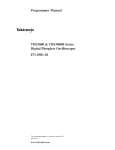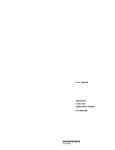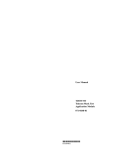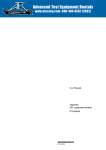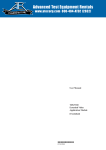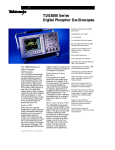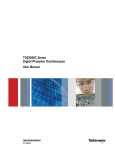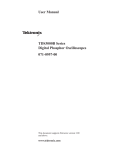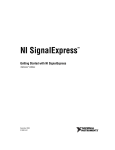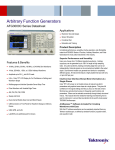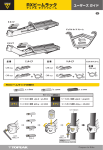Download TDS3TRG Advanced Trigger Application Module User Manual
Transcript
User Manual TDS3TRG Advanced Trigger Application Module 071-0306-01 *P071030601* 071030601 Copyright © Tektronix, Inc. All rights reserved. Tektronix products are covered by U.S. and foreign patents, issued and pending. Information in this publication supercedes that in all previously published material. Specifications and price change privileges reserved. Tektronix, Inc., P.O. Box 500, Beaverton, OR 97077 TEKTRONIX, TEK, TEKPROBE, and Tek Secure are registered trademarks of Tektronix, Inc. DPX, WaveAlert, and e*Scope are trademarks of Tektronix, Inc. WARRANTY SUMMARY Tektronix warrants that the products that it manufactures and sells will be free from defects in materials and workmanship for a period of one (1) year from the date of shipment from an authorized Tektronix distributor. If a product proves defective within the respective period, Tektronix will provide repair or replacement as described in the complete warranty statement. To arrange for service or obtain a copy of the complete warranty statement, please contact your nearest Tektronix sales and service office. EXCEPT AS PROVIDED IN THIS SUMMARY OR THE APPLICABLE WARRANTY STATEMENT, TEKTRONIX MAKES NO WARRANTY OF ANY KIND, EXPRESS OR IMPLIED, INCLUDING WITHOUT LIMITATION THE IMPLIED WARRANTIES OF MERCHANTABILITY AND FITNESS FOR A PARTICULAR PURPOSE. IN NO EVENT SHALL TEKTRONIX BE LIABLE FOR INDIRECT, SPECIAL OR CONSEQUENTIAL DAMAGES. Contacting Tektronix Product Support For questions about using Tektronix measurement products, call toll free in North America: 1-800-833-9200 6:00 a.m. – 5:00 p.m. Pacific time Or contact us by e-mail: [email protected] For product support outside of North America, contact your local Tektronix distributor or sales office. Service Support Tektronix offers a range of services, including Extended Warranty Repair and Calibration services. Contact your local Tektronix distributor or sales office for details. Contents Safety Summary . . . . . . . . . . . . . . . . . . . . . . . . . . . . Installing the Application Module . . . . . . . . . . . . . . . Advanced Trigger Features . . . . . . . . . . . . . . . . . . . . Accessing Advanced Triggering . . . . . . . . . . . . . . . . Advanced Trigger Concepts . . . . . . . . . . . . . . . . . . . Conventions . . . . . . . . . . . . . . . . . . . . . . . . . . . . . . . Pattern Triggering . . . . . . . . . . . . . . . . . . . . . . . . . . . State Triggering . . . . . . . . . . . . . . . . . . . . . . . . . . . . . Pulse Width Triggering . . . . . . . . . . . . . . . . . . . . . . . Runt Pulse Triggering . . . . . . . . . . . . . . . . . . . . . . . . Slew Rate Triggering . . . . . . . . . . . . . . . . . . . . . . . . . Specifications . . . . . . . . . . . . . . . . . . . . . . . . . . . . . . 2 5 5 7 8 14 15 17 19 22 25 28 For a listing of worldwide service centers, visit our web site. Toll-free Number In North America: 1-800-833-9200 An operator can direct your call. Postal Address Tektronix, Inc. Department or name (if known) P.O. Box 500 Beaverton, OR 97077 USA Web Site www.tektronix.com 1 Safety Summary To avoid potential hazards, use this product only as specified. While using this product, you may need to access other parts of the system. Read the General Safety Summary in other system manuals for warnings and cautions related to operating the system. Preventing Electrostatic Damage CAUTION. Electrostatic discharge (ESD) can damage components in the oscilloscope and its accessories. To prevent ESD, observe these precautions when directed to do so. Handle Components Carefully. Do not slide sensitive components over any surface. Do not touch exposed connector pins. Handle sensitive components as little as possible. Transport and Store Carefully. Transport and store sensitive components in a static-protected bag or container. Manual Storage The oscilloscope front cover has a convenient place to store this manual. Use a Ground Strap. Wear a grounded antistatic wrist strap to discharge the static voltage from your body while installing or removing sensitive components. Use a Safe Work Area. Do not use any devices capable of generating or holding a static charge in the work area where you install or remove sensitive components. Avoid handling sensitive components in areas that have a floor or benchtop surface capable of generating a static charge. 2 3 Installing the Application Module Please refer to the TDS3000 & TDS3000B Series Application Module Installation Manual for information on installing your application module. Advanced Trigger Features The TDS3TRG Advanced Trigger application module adds logic and pulse triggering capabilities to your TDS3000 series oscilloscope. This section provides an overview of these new features. Logic Trigger Features Logic triggering triggers the oscilloscope when two signals meet a Boolean logic condition. The advanced trigger module provides pattern and state logic trigger modes. Pattern Trigger. Pattern triggering triggers the oscilloscope when two signals become logically true or false. Basically, the pattern-triggering feature triggers the oscilloscope from the output of a two-input AND, OR, NAND, or NOR logic gate. You can specify time constraints and signal threshold levels as part of the triggering condition. This trigger is useful for digital logic troubleshooting. 4 5 State Trigger. State triggering triggers the oscilloscope when a state signal is true or false at the time a clock signal transition is true. This trigger is useful for troubleshooting digital logic synchronous state machines. Pulse Trigger Features Pulse triggering triggers the oscilloscope when a signal meets a timing or threshold condition. The advanced trigger module provides three pulse trigger modes: pulse width, runt pulse, and slew rate. Pulse Width. Pulse-width triggering triggers the oscilloscope when a signal pulse width is less than, greater than, equal to, or not equal to a specified pulse width. This trigger is useful for digital logic troubleshooting. Slew Rate. Slew-rate triggering triggers the oscilloscope when a signal’s slew rate (rise or fall time) is less than, greater than, equal to, or not equal to a specified slew rate. This trigger is useful for troubleshooting digital bus transceivers, transmission lines, and op-amp circuits. Accessing Advanced Triggering 1. Push the Trigger MENU button to display the Trigger screen buttons. 2. Push the Type bottom screen button to display the trigger type pop-up menu. 3. Push the Type bottom screen button to select Logic or Pulse triggering. 4. Push the Class screen button to select trigger class. Runt Pulse. Runt-pulse triggering triggers the oscillo- scope when a signal pulse is less than a specified threshold level. You can also specify runt pulse-width parameters. This trigger is useful for troubleshooting bus-contention problems. 6 7 Advanced Trigger Concepts This section introduces the concepts of signal logic and thresholds as they relate to advanced triggering. These concepts apply to most or all of the advanced trigger functions. You should read this section if you are not familiar with advanced triggering concepts or Boolean logic. Overview Edge triggering can trigger on most signals, and is the default trigger type. Edge triggering sets the oscilloscope to trigger (acquire signal data) when a signal meets a specified signal slope and a single voltage-threshold condition. However, there are times when you need to trigger the oscilloscope on a more complex signal, or when two signals meet a condition, in order to troubleshoot a particular problem. These problems include a pulse that is too narrow or wide, and situations in which one signal is true when a second signal transitions from low to high. Advanced triggering can help acquire signals with these types of problems. Advanced triggering lets you further qualify the trigger conditions by adding parameters such as pulse width, delta time, logical comparisons of two signals, and dual threshold levels. Pulse width Runt pulse Single threshold voltage setting = Trigger point Thresholds = Possible trigger points for positive slope signals 8 Both pulse and logic triggering trigger the oscilloscope when one or two signals are logically true. To determine whether a signal is true or false, you must set a signal reference point that determines whether a signal is in one of two states. You set this reference point by specifying a threshold voltage level for each trigger signal. Crossing the threshold level toggles the state value of that signal. 9 High-true logic Single threshold voltage setting True True False High logic state Low logic state Low logic state Low-true logic False False True = Transition point from one state to another Logic State Boolean Logic The actual state (true or false) of a signal depends on how you define its signal logic setting, which can be either high-true or low-true. Defining a signal as hightrue (H) means that signal levels above (more positive than) the threshold level are true, and signal levels below (more negative than) the threshold level are false. A low-true (L) logic setting is just the opposite. Defining a signal as low-true means that signal levels below (more negative than) the threshold level are true, and signal levels above (more positive than) the threshold level are false. Low logic effectively inverts the signal. Defining the logical state of a signal lets you use Boolean logic to evaluate when a condition is true for two signals. The signal logic (threshold level and high-true/low-true logic) defines which part of a waveform cycle is true or false. You then use Boolean logic to evaluate or compare the logic of two signals as part of a trigger condition. The four logical comparison functions are AND, OR, NAND, and NOR: H The AND function means that if both signal logic states are true, the condition is true, otherwise the condition is false. 10 H The OR function means if either or both signal logic states are true, the condition is true, otherwise the condition is false. 11 H The NAND (Not-AND) function means that if both signal logic states are true, the condition is false, otherwise the condition is true. This function is the inverse of the AND function. H The NOR (Not-OR) function means if any or all of the trigger signal logic states are true, the condition is false, otherwise the condition is true. This function is the inverse of the OR function. Remember that the logic function evaluates the logic states of two signals, and that the logic state of each signal depends on whether they are set to high-true or low-true logic. For example, assume that you want to trigger the oscilloscope only when signal one is low at the same time that signal two is high. Therefore you want to: H Set a threshold level that is appropriate for each signal. H Set signal one to be true when it is low (low-true signal logic). 12 H Set signal two to be true when the signal is high (high-true signal logic). H Trigger when both conditions are true (AND trigger logic). Trigger logic: Signal 1 AND Signal 2 Signal 1 logic = low true Threshold settings Signal 2 logic = high true Pattern is true: trigger The material you have just read provides a basic understanding of the triggering concepts you need in order to use the Logic and Pattern triggering functions. Refer to the Reference section for detailed information about the advanced trigger functions. 13 Conventions Pattern Triggering The following conventions apply to all advanced trigger functions: H You cannot use any of the advanced trigger functions to arm B triggering. Pattern Trigger Conditions H You do not have to display a channel in order to use the channel as a trigger source. H The range of time values for pulse width (regular and runt) and slew rate is from 39.6 ns to 10 s. H In the menu tables, N represents a numeric value entered using the general purpose knob. Define Inputs Thresholds H Define logic AND Input 1 L H OR Trigger when Goes true/false Delta time Trigger NAND Input 2 NOR L True <,>,=,0time Pattern Trigger Menu Table 1: Trigger Menu: Type = Logic, Class = Pattern Bottom Side Description Define Inputs Input 1 Source Sets the pattern trigger signal input 1 source. Logic Sets the signal logic for input 1. H = high true, L = low true. Input 2 Source Sets the pattern trigger signal input 2 source. Logic Sets the signal logic for input 2. H = high true, L = low true. AND, OR, NAND, NOR Sets which logic function to apply to the input signals. Define Logic 14 15 Table 1: Trigger Menu: Type = Logic, Class = Pattern (cont.) Bottom Side Description Trigger When Goes True/ Goes False Triggers the oscilloscope when the logic condition is true or false. Triggers the oscilloscope when the input logic condition is true for a time period greater than or less than time period N. Is True < N Is True > N Is True = N Is True 0 N Thresholds Level (Input 1) N Level (Input 2) N Mode & Holdoff Triggers the oscilloscope when the input logic condition is true for a time period equal to or not equal to time period N within a ±5% tolerance. Sets the threshold voltage level for input 1 and 2 to level N, using the general purpose knob. Set to TTL Sets the threshold voltage level to 1.4 V for both inputs. Set to ECL Sets the threshold voltage level to –1.3 V for both inputs. Set to 50% Sets the threshold voltage level to 50% of each input’s peak-topeak value. Same as Edge Trigger. State Triggering State Trigger Conditions Define inputs Thresholds H Trigger when S State Q L Q C True Trigger False Clock State Trigger Menu Table 2: Trigger Menu: Type = Logic, Class = State Bottom Side Description Define Inputs State Input Source Sets the state signal source. Logic Sets the signal logic for state input source. H = high true, L = low true. Sets the clock signal source. Clock Input Source Slope Sets the signal slope (rising or falling) for clock input. The clock slope defines when the clock signal is true. Trigger When. The input condition must be true or false for ≥2 ns in order for the oscilloscope to detect the pattern. 16 17 Table 2: Trigger Menu: Type = Logic, Class = State (cont.) Bottom Side Description Trigger When Goes True Triggers the oscilloscope if the state signal is true when the clock signal slope is true. Triggers the oscilloscope if the state signal is false when the clock signal slope is true. Sets the threshold voltage level for state and clock signals to level N, using the general purpose knob. Goes False Thresholds Mode & Holdoff Level (State Input) N Level (Clock Input) N Set to TTL Pulse Width Triggering Pulse Trigger Conditions Triggers when pulse is less than width setting Triggers when pulse is greater than width setting Threshold level riggers when pulse is equal to width setting ± 5% Triggers when pulse is not equal to width setting ± 5% Sets the threshold voltage level to 1.4 V for both inputs. Set to ECL Sets the threshold voltage level to –1.3 V for both inputs. Set to 50% Sets the threshold voltage level to 50% of each input’s peak-topeak value. Same as Edge Trigger. Threshold level Tolerance Tolerance = Trigger point Trigger When. The state signal must be true or false for ≥2 ns prior to the clock transition in order for the oscilloscope to detect the state. 18 19 Table 3: Trigger Menu: Type = Pulse, Class = Width (cont.) Pulse Width Trigger Menu Table 3: Trigger Menu: Type = Pulse, Class = Width Bottom Side Description Source Ch1 - Ch4 Sets the pulse width signal source. Sets external or external divided by 10 as the signal source. Ext Ext/10 AC Line Vert Polarity Positive Negative Trigger When Pulse Width <N Pulse Width >N Pulse Width =N Pulse Width 0N 20 Sets the AC line frequency as the trigger source. This trigger source is only available when the oscilloscope is connected to AC power. Sets the lowest-numbered displayed channel as the trigger source. Sets the source signal pulse polarity on which to trigger. Bottom Side Description Level Level N Sets the signal threshold voltage level to N using the general purpose knob. Sets the signal threshold voltage level to 1.4 V. Set to TTL Mode & Holdoff Set to ECL Sets the signal threshold voltage level to –1.3 V. Set to 50% Sets the threshold voltage level to 50% of the signal’s peak-topeak value. Same as Edge Trigger Trigger When. The source pulse width must be ≥5 ns in order for the oscilloscope to detect the pulse. Triggers the oscilloscope when the source signal pulse width is less than or greater than the specified pulse width N. Triggers the oscilloscope when the signal pulse width is equal to or not equal to the specified pulse width N within a ±5% tolerance. 21 Runt Pulse Triggering Runt Pulse Trigger Menu Table 4: Trigger Menu: Type = Pulse, Class = Runt Trigger Conditions Any runt (positive, negative, or either) Bottom Side Description Source Ch1 - Ch4 Ext Ext/10 AC Line Vert Positive Negative Either Runt Occurs Sets the runt signal source. Sets external or external divided by 10 as the signal source. Polarity Runt is less than width setting Runt is greater than width setting Trigger When Runt Width <N Runt is equal to width setting ± 5% tolerance Runt is not equal to width setting ± 5% tolerance Runt Width >N Runt Width =N Runt Width 0N Tolerance Same as description on page 20. Sets the source signal runt pulse polarity on which to trigger. Triggers the oscilloscope when any runt pulse is detected, regardless of width. Triggers the oscilloscope when the runt signal pulse width is less than or greater than the specified pulse width N. Triggers the oscilloscope when the runt signal pulse width is equal to or not equal to the specified pulse width N within a ±5% tolerance. Tolerance = Trigger point 22 23 Table 4: Trigger Menu: Type = Pulse, Class = Runt (cont.) Bottom Side Description Thresholds High N Sets the runt signal high threshold and low threshold voltage levels to value N, using the general purpose knob. Low N Set to TTL Set to ECL Mode & Holdoff Sets runt signal threshold voltage levels to 2.0 V (high threshold) and 0.8 V (low threshold). Sets runt signal threshold voltage levels to –1.1 V (high threshold) and –1.5 V (low threshold). Same as Edge Trigger Trigger When. The source runt pulse width must be ≥5 ns in order for the oscilloscope to detect the pulse. Slew Rate Triggering Slew Rate Trigger Conditions Signal slew rate is greater (faster) than specified slew rate Specified slew rate Actual slew rate Signal slew rate is equal to specified slew rate ±5% tolerance Tolerance Signal slew rate is less (slower than specified slew rate Specified slew rate Actual slew rate Signal slew rate is not equal to specified slew rate ±5% tolerance Tolerance = Trigger point 24 25 Slew Rate Trigger Menu Table 5: Trigger Menu: Type = Pulse, Class = Slew Rate (cont.) Table 5: Trigger Menu: Type = Pulse, Class = Slew Rate Bottom Side Description Source Ch1 - Ch4 Sets the slew rate signal source. Sets external or external divided by 10 as the signal source. Polarity Trigger When Ext Ext/10 AC Line Vert Positive Negative Either Slew Rate < N Slew Rate > N Slew Rate =N Slew Rate 0N Delta Time N 26 Bottom Side Description Thresholds High N Sets the signal high threshold and low threshold voltage level components of the slew rate to value N, using the general purpose knob. Low N Set to TTL Same as description on page 20. Sets the source signal slew rate polarity on which to trigger. Triggers the oscilloscope when the signal slew rate is less than or greater than the specified slew rate N. Triggers the oscilloscope when the signal slew rate is equal to or not equal to the specified slew rate N within a ±5% tolerance. Shows the delta time component N of the slew rate, as set using the general purpose knob. Set to ECL Mode & Holdoff Sets the signal threshold voltage levels to 2.0 V (high threshold) and 0.8 V (low threshold). Sets the signal threshold voltage levels to –1.1 V (high threshold) and –1.5 V (low threshold). Same as Edge Trigger Delta Time and Thresholds. The delta time and threshold settings determine the calculated slew rate (volts ÷ time). Changing either value changes the calculated slew rate. Trigger When. The delta time component of the slew rate (time from threshold to threshold) must be ≥5 ns in order for the oscilloscope to detect the slew rate. 27 Specifications Table 6: TDS3TRG specifications (cont.) This section describes the TDS3TRG Advanced Trigger application module specifications. All specifications are guaranteed unless labeled ”typical.” Typical specifications are provided for your convenience but are not guaranteed. To meet specifications, two conditions must first be met: H The oscilloscope must have been operating continuously for ten minutes within the operating temperature range specified. H You must perform the Compensate Signal Path operation described in the oscilloscope user manual. If the operating temperature changes by more than 10° C, you must perform the Compensate Signal Path operation again. Table 6: TDS3TRG specifications Characteristic Description Logic and Pulse Trigger Sensitivity, typical 1.0 division at BNC, DC Coupled, ≥10 mV/div to ≤ 1 V/div (pattern, state, delay, width, and runt triggering) Same as Edge Trigger Sensitivity specifications in the oscilloscope user manual. Slew Rate Trigger Sensitivity, typical 28 Characteristic Description Logic Triggering Minimum Logic Time, typical Pattern State 2 ns 2 ns Pattern minimum logic time: the time that a logic pattern must be valid to be recognized. State minimum logic time: the time that a logic state must be valid before and after the clock edge to be recognized. Logic Triggering Minimum Rearm Time, typical Pattern State 2 ns 4 ns Pattern minimum rearm time: the time that a logic pattern must be invalid before a new occurrence of the pattern is recognized. State minimum rearm time: the time between consecutive clocks. Pulse Triggering Minimum Pulse Width, typical 5 ns For pulse and runt, minimum pulse width refers to the pulse being measured. For slew rate, minimum pulse width means the minimum delta time that the oscilloscope recognizes. 29 Table 6: TDS3TRG specifications (cont.) Characteristic Description Pulse Triggering Minimum Rearm Time, typical 5 ns For pulse and runt, rearm time refers to the time between measured pulses. For slew rate, rearm time refers to the time it takes the signal to recross the two signal thresholds. Time Range Resolution 39.6 ns to 9.99 ms 13.2 ns 10 ms to 99.9 ms 92.4 ns 100 ms to 999 ms 1 ms 1 ms to 9.99 ms 10 ms 10 ms to 99.9 ms 100 ms 100 ms to 999 ms 1 ms 1 s to 10 s 10 ms Delta Time Resolution using general purpose knob 30


















